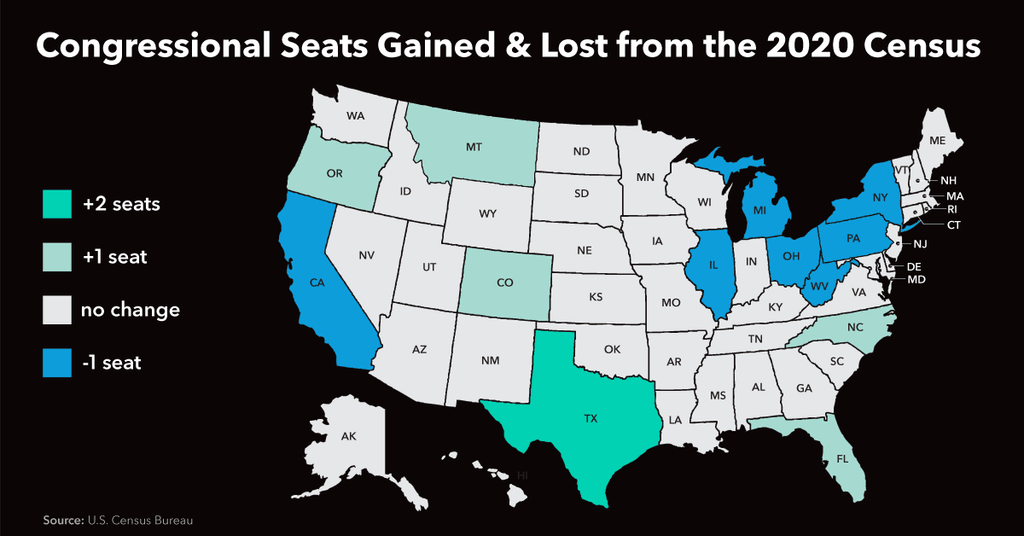ARTICLE
Who Draws the Lines – Congressional Redistricting
Once a decade, state legislators and commissions redraw congressional districts based upon findings from the U.S. Census, which is a constitutionally mandated population count. The 2020 U.S. Census results played a pivotal role in the outcome of the 2022 midterm election, spurring partisan clashes and ongoing litigation. This article outlines who and how the redistricting process works and the impact it had on the 2022 midterm elections.
Who draws congressional districts?
States have different entities in charge of redrawing congressional districts. Some states – such as Washington, California, Arizona, and others – have independent or bipartisan commissions in charge. However, most states have legislators who draw district lines.
Republican or Democrat-controlled legislation can influence where the lines are drawn and give their party an advantage. Partisan mapmakers can craft strong and difficult-to-flip districts by dividing their opposition party’s supporters across many districts or into a single district to dilute voting power. This process is known as gerrymandering.
Six states adopted new systems for drawing lines to force bipartisan consensus and improve the redistricting process. Using commissions has been one such means of reform. However, partisan power still reigned supreme in 2021, with 28 states who utilized legislators to determine new maps.
The path to a commission
A growing number of states have shifted redistricting power away from legislators to various commissions. For example, Arizona established an independent commission in 2000 in attempts to end gerrymandering practices.
Arizona’s commission is made up of five members. Lawmakers appoint two Democrats and two Republican commissioners from a pool of applicants, and the cohort of partisan members select an independent chair. Although lawmakers play a role in selecting commissioners, they do not get to vote on updated maps.
Other states have different types of commissions, with specific criteria on appointee selections and map-making processes.
When does redistricting occur?
When data from the Census is released, the redistricting process begins. Population changes impact whether a state gains or loses seats in the U.S. House of Representatives. The Senate count, though, is unaffected by population changes.
Typically, state population numbers are due at the end of the year. However, due to the Covid-19 pandemic, the 2020 Census results were delayed until April 2021.
On Aug. 12, 2021, the U.S. Census Bureau released block-by-block population counts. Census blocks are areas bounded by visible features (such as roads and railroads) and nonvisible boundaries (like property lines and county limits.) These blocks allow states to form equal-sized districts to account for population fluctuations.
Although states redraw district lines every ten years, courts may invalidate maps mid-decade and impose new lines or direct legislatures to do so, which happened in 2011 in Florida, Virginia, North Carolina, and Pennsylvania.
How does the redistricting process work?
- U.S. Census Bureau provides states with initial population numbers.
- The Bureau gives states block-by-block population counts.
- Map makers can begin redistricting but must ensure districts are equal in population size and safeguard voters based on race or ethnicity, per the Voting Rights Act.
- Depending on the state, additional rules or criteria might be enacted.
How did the 2020 census shape the 2022 political landscape?
Maps made by state legislators and commissions affected 2022 midterm outcomes. Republican majorities often gave redistricting advantages to the GOP; similarly, this occurred with Democrat-controlled states. Other factors, such as incumbent retirements, candidate recruitment, campaign quality, and Biden’s approval ratings, also affected midterm results. Redistricting lines, nonetheless, played a significant role in congressional gains or loss and will continue to have a political impact for the next decade to come.
Gainers and losers from the 2020 Census

The map above shows states that either gained or lost a seat(s) in the House:
- Texas is the only state that gained two seats. Colorado, Florida, Montana, North Carolina, and Oregon all won one additional seat.
- Six states in the industrial north – New York, Pennsylvania, West Virginia, Ohio, Michigan, and Illinois – lost one seat. Likewise, California lost a seat for the first time ever.
- New York lost a seat after falling short by just 89 residents; however, it was in danger of losing two seats.
- The Sun Belt benefited from booming Latino populations as well as from people moving away from more liberal states, such as New York.
Congressional reapportionment and the 2020 Census
Reapportionment – the reassignment of House seats – is a zero-sum game. For one state to gain representation, another must lose.
As of April 1, 2020, the total U.S. population for apportionment was 331,108,434. Although it varies widely by state, the average House district now has 761,169 people, which is up from 710,767 in 2010.
As indicated in the map above, due to reapportionment, six states gained House seats and seven lost them. This change in congressional representation reflects a migration to southern and western states.
Redistricting and the 2022 midterm elections
Republican legislators drew far more congressional districts and state legislative maps than their Democrat counterparts. As a result, GOP-controlled states netted several seats in the 2022 midterm elections, including in Florida and Ohio.
“Republicans focused on putting a lot of their vulnerable incumbents into politically safe zones,” said Greg Giroux, Bloomberg Government’s senior elections reporter during a midterm elections outlook and state policy event.

This occurred in Florida where gerrymandered maps put GOP officials at a political advantage. Several Democratic-led groups sued for unconstitutional redistricting, but the state’s appellate courts didn’t require legislators to redraw fairer, more competitive maps before the 2022 midterm cycle.
Republican and Democrats have filed lawsuits in other states to challenge congressional district and state legislative maps. Litigation is still ongoing. Request a demo.